coolant temperature PONTIAC GRAND-AM 1993 Owners Manual
[x] Cancel search | Manufacturer: PONTIAC, Model Year: 1993, Model line: GRAND-AM, Model: PONTIAC GRAND-AM 1993Pages: 306, PDF Size: 15.39 MB
Page 7 of 306
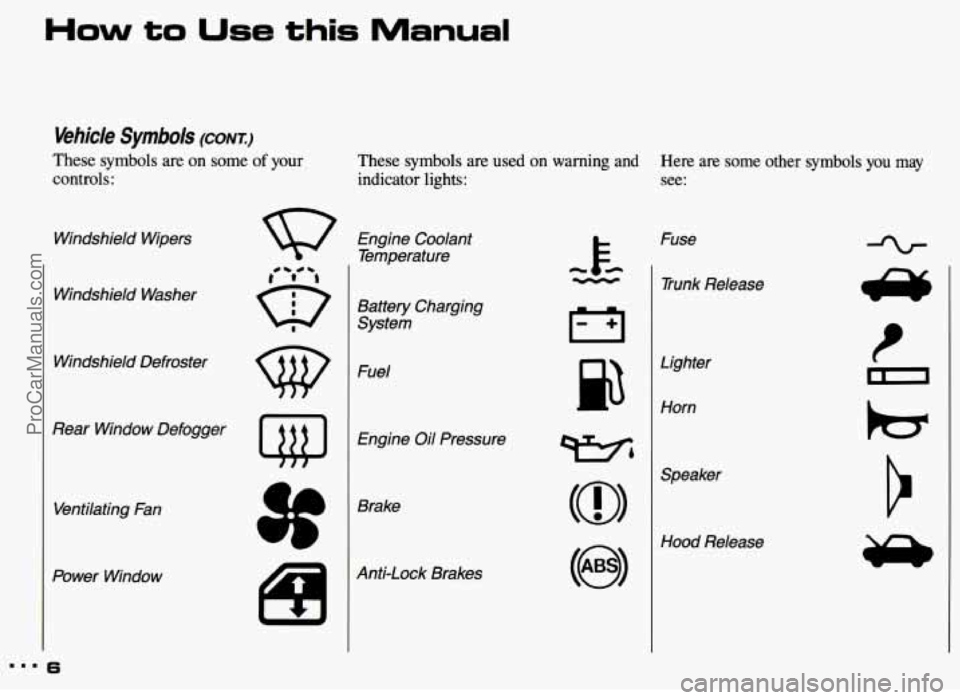
How to Use this Manual
Vehicle Symbols (CONT.:)
These symbols are on some of your
controls:
Windshield Wipers
Windshield Washer
Windshield Defroster
Rear Window Defogger
Ventilating Fan
Power Window
These symbols are used on warning and
Here are some other symbols you may
indicator lights: see:
Engine Coolant
Temperature
Battery Charging
System
Fuel
Engine Oil Pressure
Brake
Anti-Lock Brakes Fuse
(0)
Speaker
(@I
Hood Release
... 6
ProCarManuals.com
Page 93 of 306
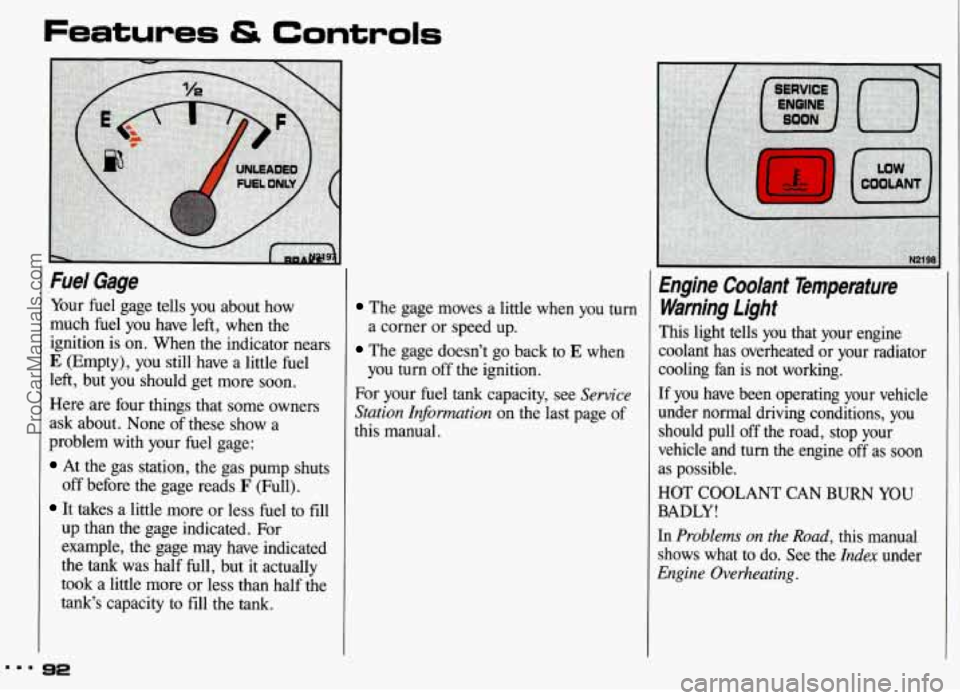
Fuel Gage
Your fuel gage tells you about how
much fuel you have left, when the
ignition is on. When the indicator nears
E (Empty), you still have a little fuel
left, but you should get more soon.
Here are four things that some owners
ask about. None
of these show a
problem with
your fuel gage:
At the gas station, the gas pump shuts
off before the gage reads
F (Full).
It takes a little more or less fuel to fill
up than the gage indicated. For
example, the gage may have indicated
the
tank was half full, but it actually
took a little more or less than half the
tank’s capacity to fill the tank.
The gage moves a little when you turn
The gage doesn’t go back to E when
For your fuel tank capacity, see
Service
Station Information
on the last page of
this manual. a
corner or speed up.
you turn off the ignition.
Engine Coolant Temperature
Warning Light
This light tells you that your engine
coolant has overheated or your radiator
cooling fan is not working.
If you have been operating your vehicle
under normal driving conditions, you
should pull off the road, stop your
vehicle and turn the engine
off as soon
as possible.
HOT
COOLANT CAN BURN YOU
BADLY!
In Problems on the Road, this manual
shows what to do. See the
Index under
Engine Overheating.
ProCarManuals.com
Page 94 of 306
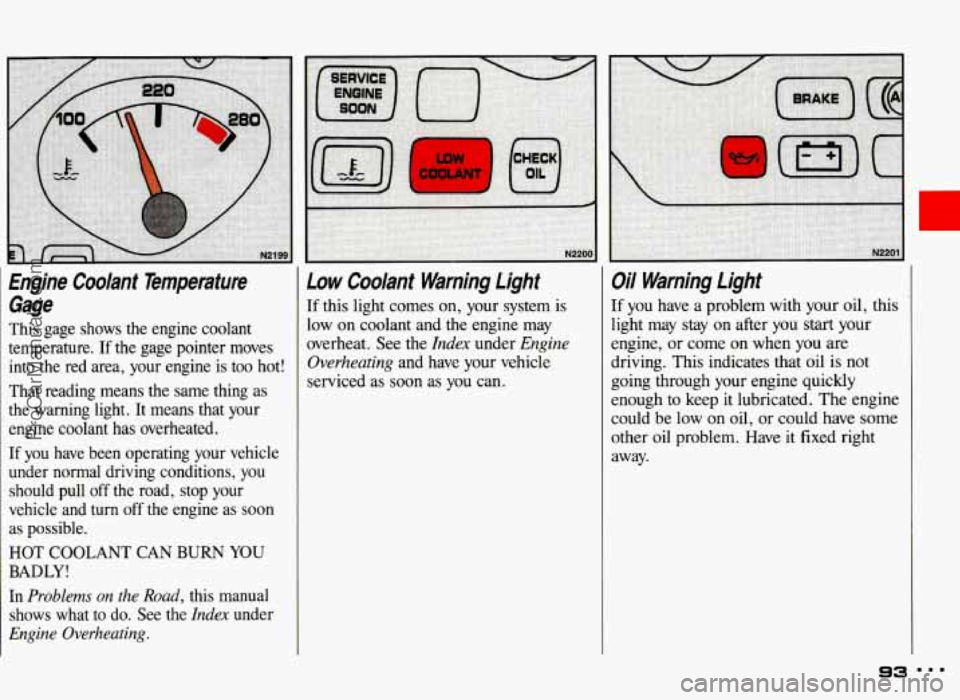
Engine Coolant Temperature Gage
This gage shows the engine coolant
temperature. If the gage pointer moves
into the red area, your engine is too hot!
That reading means the same thing as
the warning light. It means that your
engine coolant has overheated.
If you have been operating your vehicle
under normal driving conditions, you
should pull
off the road, stop your
vehicle and
turn off the engine as soon
as possible.
HOT
COOLANT CAN BURN YOU
BADLY!
In Problems on the Road, this manual
shows what to do. See the
Index under
Engine Overheating.
Low Coolant Warning light
If this light comes on, your system is
low on coolant and the engine may
overheat. See the
Index under Engine
Overheating
and have your vehicle
serviced as
soon as you can.
Oil Warning Llght
If you have a problem with your oil, this
light may stay on after you
start your
engine, or come
on when you are
driving. This indicates that
oil is not
going through your engine quickly
enough to keep it lubricated. The engine
could be low on oil, or could have some
other
oil problem. Have it fixed right
away.
93
ProCarManuals.com
Page 103 of 306
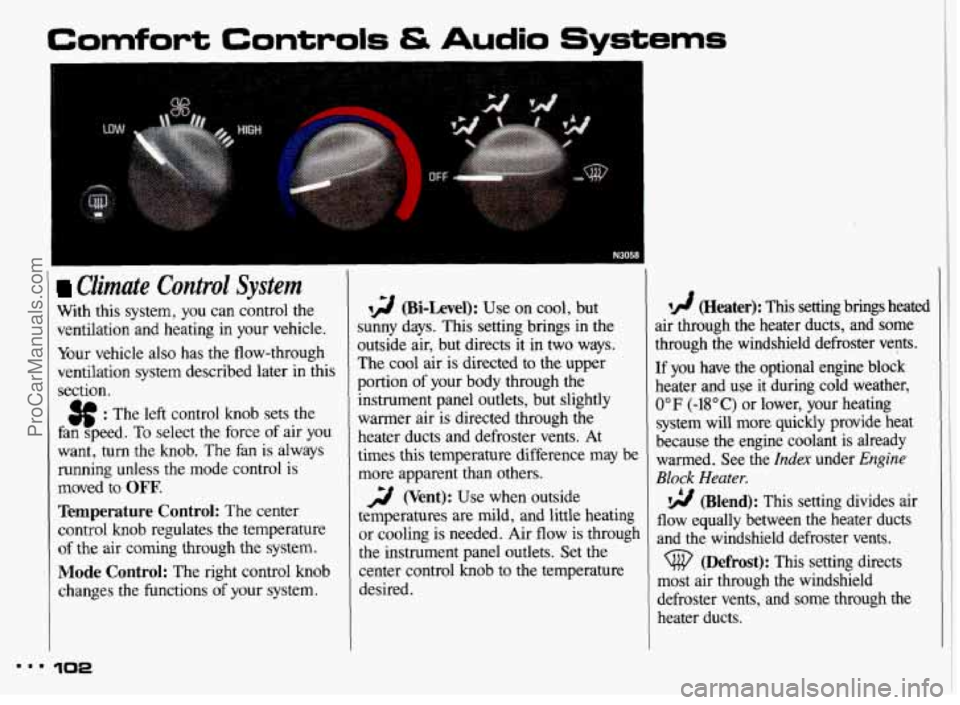
Comfort Controls & Audio Systems
Climate Control System
With this system, you can control the
ventilation and heating in your vehicle.
Your vehicle also has the flow-through
ventilation system described later in this
section.
$$ : The left control knob sets the
fan speed.
To select the force of air you
want, turn the knob. The fan
is always
running unless the mode control
is
moved to OFF’.
Temperature Control: The center
control knob regulates the temperature
of the air coming through the system.
Mode Control: The right control knob
changes the functions
of your system.
N3058
12 (Bi-Level): Use on cool, but
;unny days. This setting brings in the
3utside air, but directs it in two ways.
rhe cool air is directed to the upper
2ortion
of your body through the
instrument panel outlets, but slightly
warmer air
is directed through the
heater ducts and defroster vents. At
times this temperature difference may be
more apparent than others.
temperatures are mild, and little heating
or cooling is needed. Air flow is through
the instrument panel outlets. Set the
center control
knob to the temperature
desired.
2 (Vent): Use when outside
lA (Heater): This setting brings heated
air through the heater ducts, and some
through the windshield defroster vents.
[f you have the optional engine block
heater and use it during cold weather,
0°F (-18°C) or lower, your heating
system will more quickly provide heat
because the engine coolant is already
warmed. See the
Index under Engine
Block Heater.
flow equally between the heater ducts
and the windshield defroster vents.
most air through the windshield
defroster vents, and some through the
heater ducts.
(Blend): This setting divides air
(Defrost): This setting directs
m.. 102
ProCarManuals.com
Page 105 of 306
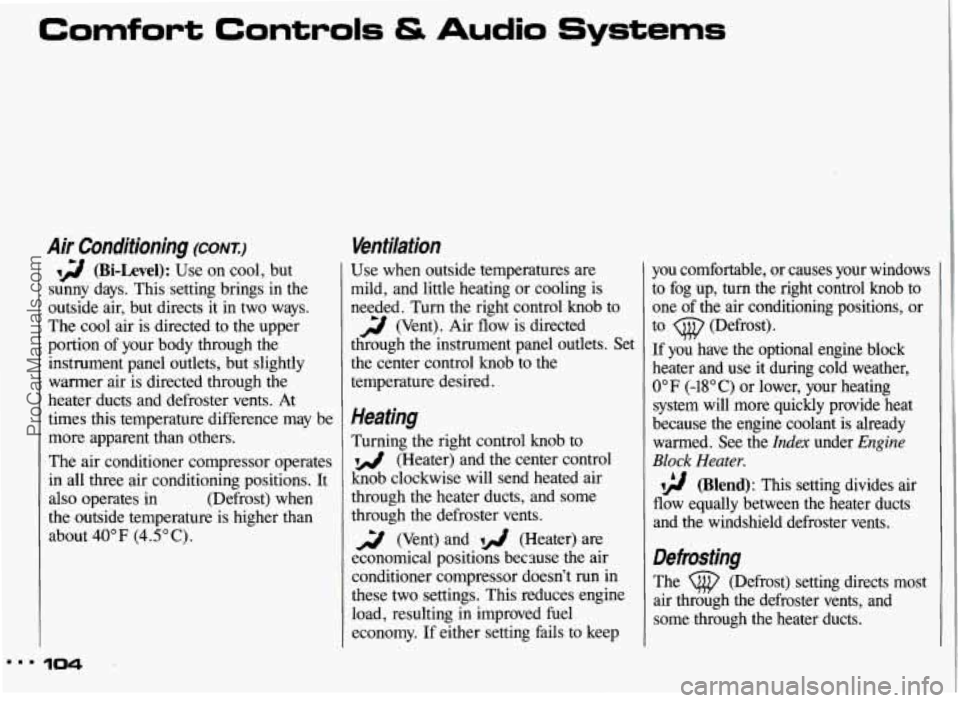
Comfort Controls & Audio Systems
Air Conditionina (CONI) -.
qg (Bi-Level): Use on cool, but
sunny days. This setting brings in the
outside air, but directs it in two ways.
The cool air is directed to the upper
portion of your body through the
instrument panel outlets, but slightly
warmer air is directed through the
heater ducts and defroster vents. At
times this temperature difference may be
more apparent than others.
The air conditioner compressor operates
in all three air conditioning positions. It
also operates in (Defrost) when
the outside temperature is higher than
about
40°F (4.5"C).
Ventilation
Use when outside temperatures are
mild, and little heating or cooling is
needed. Turn the right control knob to
2 (Vent). Air flow is directed
through the instrument panel outlets. Set
the center control knob to the
temperature desired.
Heating
Turning the right control knob to
72 (Heater) and the center control
knob clockwise will send heated air
through the heater ducts, and some
through the defroster vents.
3 (Vent) and (Heater) are
economical positions because the air
conditioner compressor doesn't run in
these two settings. This reduces engine
load, resulting in improved fuel
economy. If either setting fails to keep you
comfortable, or causes your windows
to fog up, turn the right control knob to
one of the air conditioning positions, or
to
(j@ (Defrost).
If you have the optional engine block
heater and use it during cold weather,
0°F (-18°C) or lower, your heating
system will more quickly provide heat
because the engine coolant is already
warmed. See the
Index under Engine
Block Heater.
flow equally between the heater ducts
and the windshield defroster vents.
vg (Blend): This setting divides air
Defrosting
The (@ (Defrost) setting directs most
air through the defroster vents, and
some through the heater ducts.
8.8 104
ProCarManuals.com
Page 180 of 306
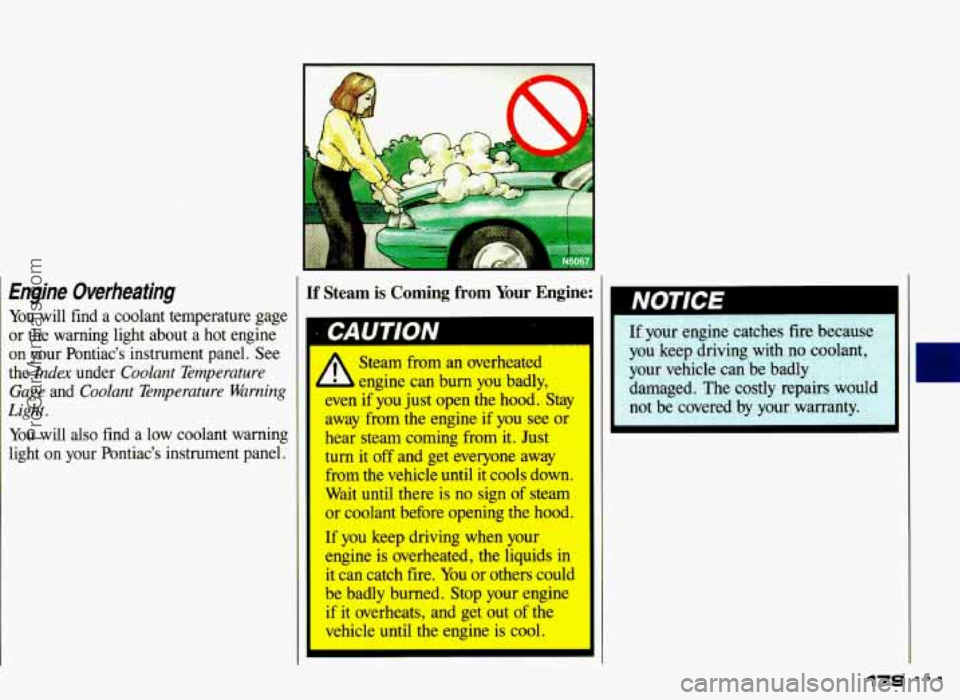
Engine Overheating
You will find a coolant temperature gage
or the warning light about
a hot engine
on your Pontiac’s instrument panel. See
the
Index under Coolant Temperature
Gage
and Coolant Temperature Warning
Light.
You will also find a low coolant warning
light on your Pontiac’s instrument panel.
If Steam is Coming from Your Engine:
/1 Steam from an overheated
L L engine can burn you badly,
even
if you just open the hood. Stay
away from the engine if you see or
hear steam coming from
it. Just
turn it off and get everyone away
from the vehicle
until it cools down.
Wait until there is no sign of steam
or coolant before opening the hood.
If you keep driving when your
engine
is overheated, the liquids in
it can catch fire. You or others could
be badly burned. Stop your engine
if it overheats, and get out of the
vehicle until the engine is cool.
179
ProCarManuals.com
Page 222 of 306
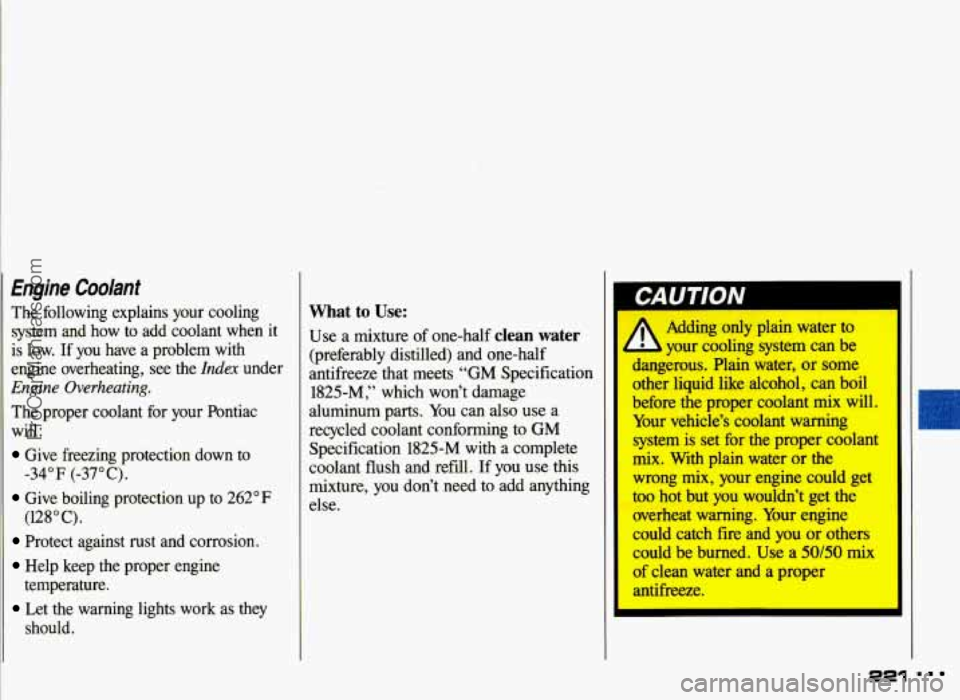
Engine Coolant
The following explains your cooling system and how to add coolant when it
is low. If you have a problem with
engine overheating, see the
Index under
Engine Overheating.
The proper coolant for your Pontiac
will:
Give freezing protection down to
Give boiling protection up to 262°F
Protect against rust and corrosion.
Help keep the proper engine
-34°F (-37°C).
(128°C).
temperature.
Let the warning
should. lights work as they
What to Use:
Use
a mixture of one-half clean water
(preferably distilled) and one-half
antifreeze that meets
“GM Specification
1825-M,” which won’t damage
aluminum parts. You can
also use a
recycled coolant conforming to GM
Specification 1825-M with a complete
coolant flush and refill. If you use this
mixture, you don’t need to add anything
else.
CAUTION I
A Adding only plain water ta
L pur cooling system can be
dangerous. Plain water, or some
other liquid like alcohol, can boil
bebe the proper coolant mix will.
system is set for the proper coolant
mix. With plain water or the
wrong mix, your engine could get
too hot but you wouldn’t get the
overheat warning, Your engine
could catch fire and you or others
could be burned. Use a 50/50 mix
of clean water and a proper
antifreeze.
Your v&hicle’s coolant warning
221 .
ProCarManuals.com
Page 224 of 306
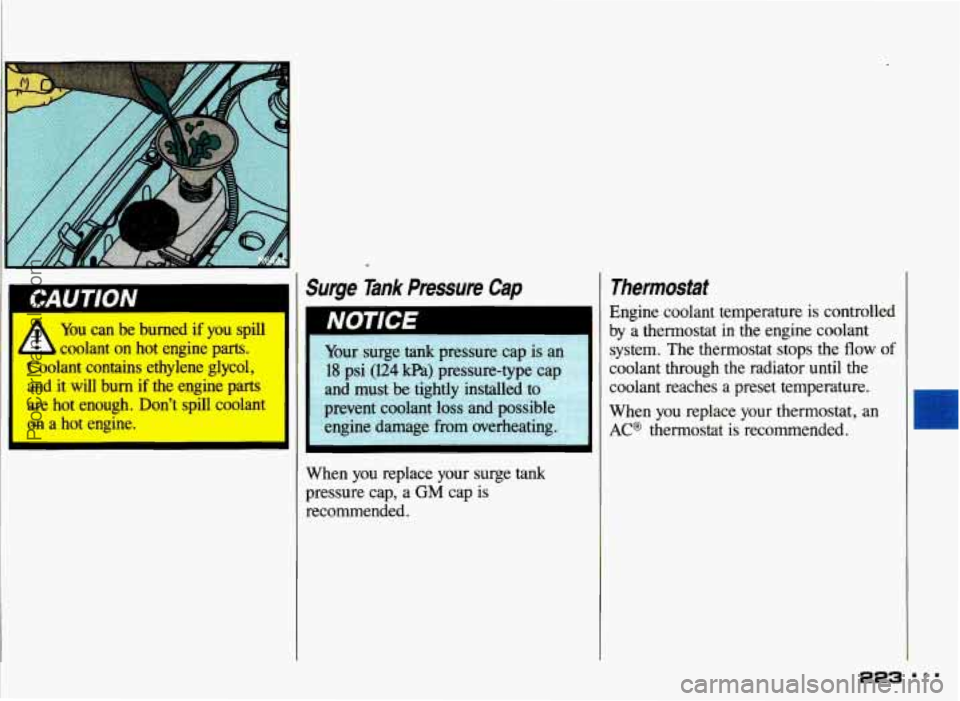
1 CAUTION
A -'-u can be burned if you spill
A Luolant on hot engine parts.
Loolant contains ethylene glycol,
and it will burn if the engine parts
are hot enough. Don't spill coolant
on a hot engine.
Surge Tank Pressure Cap
When you replace your surge tank
pressure cap, a
GM cap is
recommended.
Thermostat
Engine coolant temperature is controlled
by a thermostat
in the engine coolant
system. The thermostat stops the
flow of
coolant through the radiator until the
coolant reaches a preset temperature.
When you replace your thermostat, an
AC@ thermostat is recommended.
ProCarManuals.com
Page 270 of 306
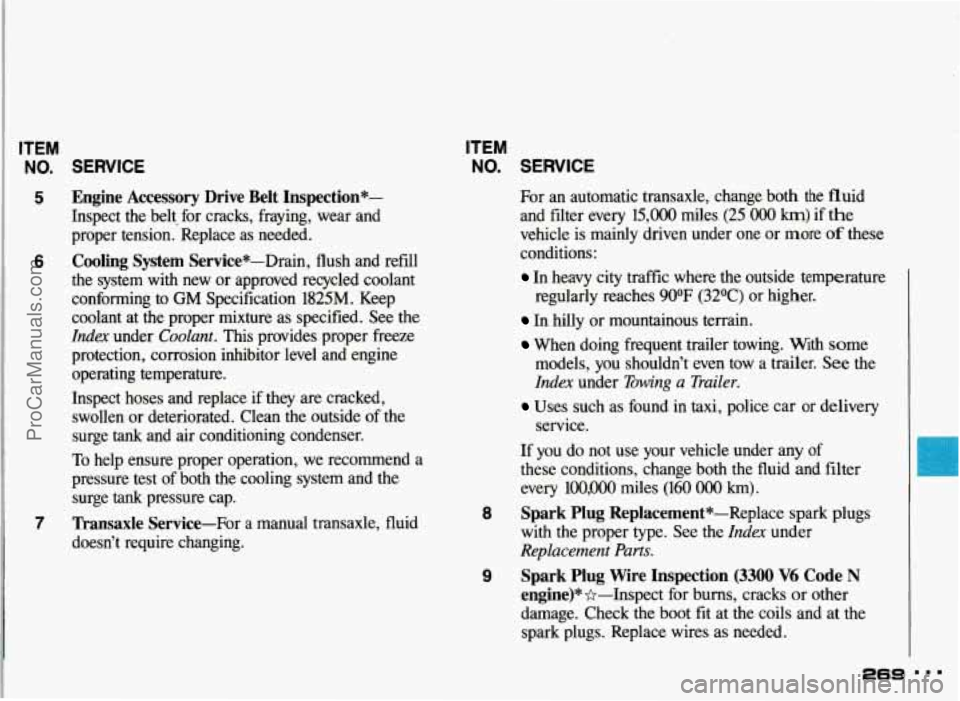
ITEM
NO. SERVICE
5 Engine Accessory Drive Belt Inspection*-
Inspect the belt. for cracks, fraying, wear and
proper tension. Replace
as needed.
6 Cooling System Service*-Drain, flush and refill
the system with new or approved recycled coolant
conforming to
GM Specification 1825M. Keep
coolant at the proper mixture as specified. See the
Index under Coolant. This provides proper freeze
protection, corrosion inhibitor level and engine
operating temperature.
Inspect hoses and replace if they are cracked,
swollen or deteriorated. Clean the outside of the
surge
tank and air conditioning condenser.
To help ensure proper operation, we recommend a
pressure test
of both the cooling system and the
surge
tank pressure cap.
doesn’t require changing.
7 Transaxle Service-For a manual transaxle, fluid
ITEM
NO. SERVICE
For an automatic transaxle, change both the fluid
and filter every
15,000 miles (25 OOO krn) if the
vehicle is mainly driven under one or more
of these
conditions:
In heavy city traffic where the outside temperature
regularly reaches 90°F
(32OC) or higher.
In hilly or mountainous terrain.
When doing frequent trailer towing. With some
models, you shouldn’t even tow a trailer. See the
Index under Towing a Trailer.
Uses such as found in taxi, police car or delivery
service.
8
9
If you do not use your vehicle under any of
these conditions, change both the fluid and filter
every 100,000 miles
(160 000 km).
Spark Plug Replacement *-Replace spark plugs
with the proper type. See the
Index under
Replacement Parts.
Spark Plug Wire Inspection (3300 V6 Code N
engine)**-Inspect for burns, cracks or other
damage. Check the boot fit at the coils and at the
spark plugs, Replace wires as needed.
ProCarManuals.com
Page 296 of 306
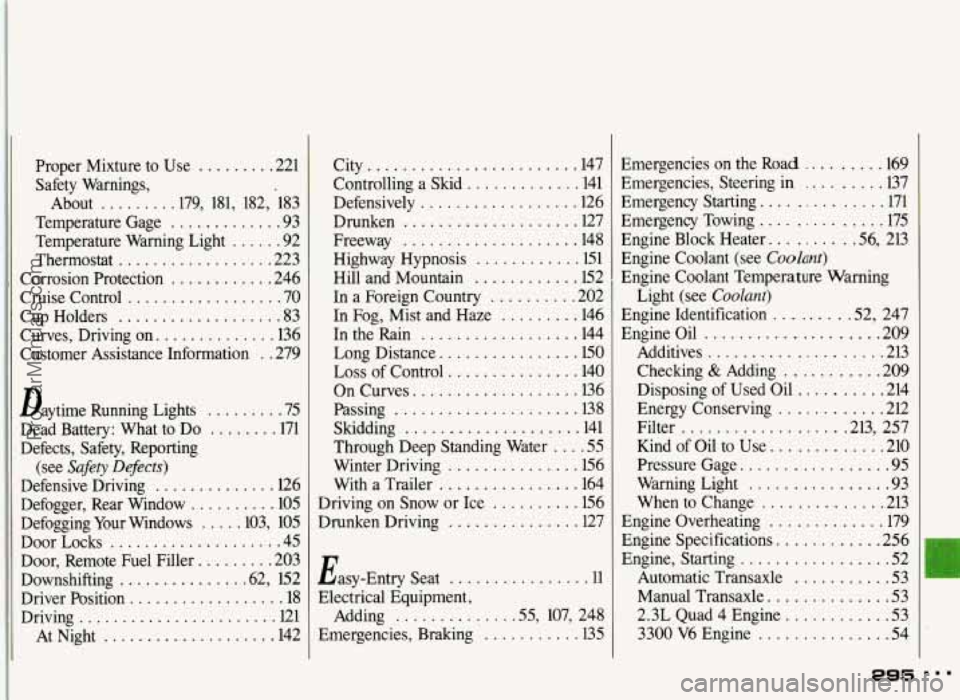
Proper Mixture to Use ......... 221
Safety Warnings. About
........ .179. 181. 182. 183
Temperature Gage
............. 93
Temperature Warning Light ...... 92
Thermostat
.................. 223
Corrosion Protection
............ 246
Cruise Control
.................. 70
Cup Holders
................... 83
Curves. Driving
on .............. 136
Customer Assistance Information
. . 279
Daytime Running Lights
......... 75
Defects. Safety. Reporting Dead Battery: What to Do
........ 171
Defensive Driving
.............. 126
(see
Safety Defects)
Defogger. Rear Window .......... 105
Defogging Your Windows
.... .103. 105
Door Locks
.................... 45
Door. Remote Fuel Filler
......... 203
Downshifting
.............. .62. 152
Driver Position
.................. 18
Driving
....................... 121
AtNight
.............. ... 142 City
........................ 147
Controlling a Skid
............. 141
Defensively
.................. 126
Drunken
.................... 127
Freeway
.................... 148
Highway Hypnosis
............ 151
Hill and Mountain
............ 152
In a Foreign Country
.......... 202
In Fog, Mist and Haze ......... 146
In the Rain
.................. 144
Long Distance ................ 150
Loss of Control
............... 140
On Curves ................... 136
Passing
..................... 138
Skidding
.................... 141
Through Deep Standing Water
.... 55
Winter Driving
............... 156
With a Trailer
................ 164
Driving on
Snow or Ice .......... 156
Drunken Driving
............... 127
Easy-Entry Seat
................ 11
Electrical Equipment, Adding
............. .55, 107, 248
Emergencies, Braking
........... 135 Emergencies
on the
Road ......... 169
Emergencies. Steering in
......... 137
Emergency Starting
.............. 171
Emergency Towing
.............. 175
Engine Block Heater
......... .56, 213
Engine Coolant (see
CooZant)
Engine Coolant Temperature Warning
Engine Identification
........ .52. 247
Engine Oil
.................... 209
Additives
.................... 213
Checking
& Adding ........... 209
Disposing of Used Oil
.......... 214
Energy Conserving
............ 212
Filter
.................. .213. 257
Kind of Oil to Use ............. 210
Pressure Gage
................. 95
Warning Light
................ 93
When to Change .............. 213
Engine Overheating
............. 179
Engine Specifications
............ 256
Engine. Starting
................. 52
Automatic Transaxle
........... 53
Manual Transaxle
.............. 53
2.3L Quad 4 Engine
............ 53
3300
V6 Engine ............... 54
295
Light (see Coolant)
ProCarManuals.com